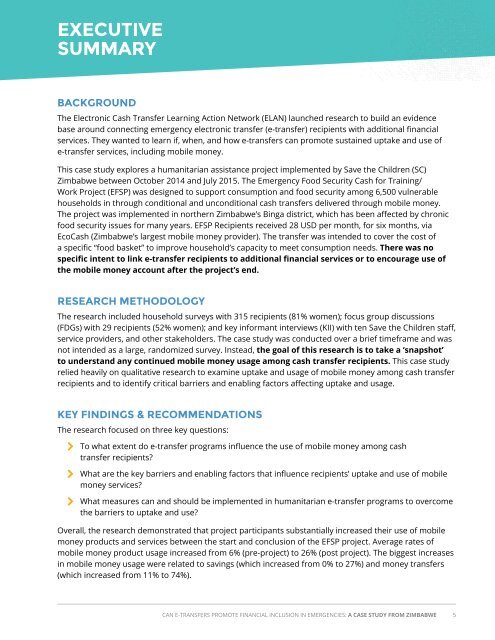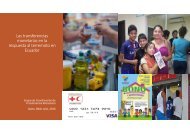Simatelele
2lF850q
2lF850q
Create successful ePaper yourself
Turn your PDF publications into a flip-book with our unique Google optimized e-Paper software.
EXECUTIVE<br />
SUMMARY<br />
BACKGROUND<br />
The Electronic Cash Transfer Learning Action Network (ELAN) launched research to build an evidence<br />
base around connecting emergency electronic transfer (e-transfer) recipients with additional financial<br />
services. They wanted to learn if, when, and how e-transfers can promote sustained uptake and use of<br />
e-transfer services, including mobile money.<br />
This case study explores a humanitarian assistance project implemented by Save the Children (SC)<br />
Zimbabwe between October 2014 and July 2015. The Emergency Food Security Cash for Training/<br />
Work Project (EFSP) was designed to support consumption and food security among 6,500 vulnerable<br />
households in through conditional and unconditional cash transfers delivered through mobile money.<br />
The project was implemented in northern Zimbabwe’s Binga district, which has been affected by chronic<br />
food security issues for many years. EFSP Recipients received 28 USD per month, for six months, via<br />
EcoCash (Zimbabwe’s largest mobile money provider). The transfer was intended to cover the cost of<br />
a specific “food basket” to improve household’s capacity to meet consumption needs. There was no<br />
specific intent to link e-transfer recipients to additional financial services or to encourage use of<br />
the mobile money account after the project’s end.<br />
RESEARCH METHODOLOGY<br />
The research included household surveys with 315 recipients (81% women); focus group discussions<br />
(FDGs) with 29 recipients (52% women); and key informant interviews (KII) with ten Save the Children staff,<br />
service providers, and other stakeholders. The case study was conducted over a brief timeframe and was<br />
not intended as a large, randomized survey. Instead, the goal of this research is to take a ‘snapshot’<br />
to understand any continued mobile money usage among cash transfer recipients. This case study<br />
relied heavily on qualitative research to examine uptake and usage of mobile money among cash transfer<br />
recipients and to identify critical barriers and enabling factors affecting uptake and usage.<br />
KEY FINDINGS & RECOMMENDATIONS<br />
The research focused on three key questions:<br />
To what extent do e-transfer programs influence the use of mobile money among cash<br />
transfer recipients?<br />
What are the key barriers and enabling factors that influence recipients’ uptake and use of mobile<br />
money services?<br />
What measures can and should be implemented in humanitarian e-transfer programs to overcome<br />
the barriers to uptake and use?<br />
Overall, the research demonstrated that project participants substantially increased their use of mobile<br />
money products and services between the start and conclusion of the EFSP project. Average rates of<br />
mobile money product usage increased from 6% (pre-project) to 26% (post project). The biggest increases<br />
in mobile money usage were related to savings (which increased from 0% to 27%) and money transfers<br />
(which increased from 11% to 74%).<br />
CAN E-TRANSFERS PROMOTE FINANCIAL INCLUSION IN EMERGENCIES: A CASE STUDY FROM ZIMBABWE 5



